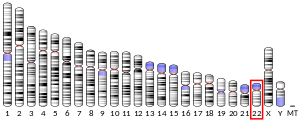XBP1
XBP1(X-box binding protein 1)は、ヒトではXBP1遺伝子にコードされるタンパク質である[5][6]。XBP1遺伝子は22番染色体上に位置するが、密接に関連する偽遺伝子が5番染色体上にも同定されている[7]。XBP1タンパク質は転写因子であり、免疫系の適切な機能や細胞ストレス応答に重要な遺伝子群の発現を調節する[8]。
発見
[編集]XBP1(X-box binding protein 1)はbZIPドメインを有する転写因子である。XBP1は、HLA-DRA遺伝子のプロモーターに存在する保存された転写エレメントである、X boxに結合する能力によって初めて同定された[6]。
機能
[編集]MHCクラスII遺伝子の調節
[編集]XBP1の発現は、MHCクラスII分子をコードする遺伝子群の一部の転写に必要である[9]。さらに、XBP1はc-fosなど他のbZIP型転写因子とヘテロ二量体化する[9]。
形質細胞の分化
[編集]XBP1は後述する小胞体ストレス応答における機能とは無関係に、形質細胞の分化を調節している[10]。XBP1が正常に発現していない場合、形質細胞の分化と関連する2つの重要な転写因子、IRF4とBlimp1の発現が異常となり、XBP1を欠く形質細胞は骨髄内のニッチでの長期生存ができなくなる[10]。
好酸球の分化
[編集]XBP1は好酸球の分化にも必要である。XBP1を欠く好酸球は、顆粒タンパク質に欠陥がみられる[11]。
血管新生
[編集]XBP1は成長因子シグナル伝達経路を介して血管内皮細胞の増殖を調節しており[12]、血管新生をもたらす。さらに、XBP1はHDAC3と相互作用することで内皮細胞を酸化ストレスから保護する[13]。
ウイルスの複製
[編集]XBP1はHTLV-1のウイルスプロモーターに結合する細胞由来転写因子として同定されている[14]。また、形質細胞分化時のXBP1sの産生は、カポジ肉腫関連ヘルペスウイルスやEBウイルスが潜伏期から再活性化するきっかけとなっているようである。
小胞体ストレス応答
[編集]XBP1は、小胞体ストレス応答の一部をなすunfolded protein response(UPR)に関与している[15]。小胞体の処理能力を超える条件下では小胞体ストレスが生じ、UPRが開始される。小胞体内でのタンパク質のフォールディングを補助するためにIRE1からGRP78が放出され[16]、IRE1はオリゴマー化して、自己リン酸化を介してリボヌクレアーゼドメインを活性化する。活性化されたIRE1は、普遍的に発現しているXBP1uのmRNAの非典型的イントロンから、pre-tRNAスプライシングに類似した機構での26ヌクレオチドの除去を触媒する。このイントロンの除去によってXBP1のコーディング配列にはフレームシフトが生じ、261アミノ酸、33 kDaのXBP1uアイソフォームではなく、376アミノ酸、40 kDaのXBP1sアイソフォームが翻訳されるようになる[17]。翻訳されたXBP1sは核へ移行し、UPR標的遺伝子の転写調節を行う[18]。
臨床的意義
[編集]XBP1の異常は小胞体ストレスの増大をもたらし、炎症過程への感受性の亢進によってアルツハイマー病に寄与している可能性がある[19]。結腸では、XBP1の異常はクローン病と関連づけられている[20]。
XBP1のプロモーター領域の多型(-116C→G)は双極性障害との関連が示唆されている。一方で性格特性と遺伝子型との相関についてはNEO-FFIスコアで女性の神経症傾向との関連が示唆されたものの、その他のスコアリングシステムでは有意な差はみられなかった[21]。
相互作用
[編集]XBP1はエストロゲン受容体αと相互作用することが示されている[22]。
出典
[編集]- ^ a b c GRCh38: Ensembl release 89: ENSG00000100219 - Ensembl, May 2017
- ^ a b c GRCm38: Ensembl release 89: ENSMUSG00000020484 - Ensembl, May 2017
- ^ Human PubMed Reference:
- ^ Mouse PubMed Reference:
- ^ “Entrez Gene: XBP1 X-box binding protein 1”. 2024年2月12日閲覧。
- ^ a b “A new member of the leucine zipper class of proteins that binds to the HLA DR alpha promoter”. Science 247 (4950): 1581–4. (March 1990). Bibcode: 1990Sci...247.1581L. doi:10.1126/science.2321018. PMID 2321018.
- ^ “An HLA-DR alpha promoter DNA-binding protein is expressed ubiquitously and maps to human chromosomes 22 and 5”. Immunogenetics 34 (5): 286–92. (1991). doi:10.1007/BF00211992. PMID 1718857.
- ^ “XBP1 is critical to protect cells from endoplasmic reticulum stress: evidence from Site-2 protease-deficient Chinese hamster ovary cells”. Cell Structure and Function 31 (2): 117–25. (2006). doi:10.1247/csf.06016. PMID 17110785.
- ^ a b “Human X-box-binding protein 1 is required for the transcription of a subset of human class II major histocompatibility genes and forms a heterodimer with c-fos”. Proceedings of the National Academy of Sciences of the United States of America 88 (10): 4309–12. (May 1991). Bibcode: 1991PNAS...88.4309O. doi:10.1073/pnas.88.10.4309. PMC 51648. PMID 1903538.
- ^ a b Hu CC, Dougan SK, McGehee AM, Love JC, Ploegh HL (June 2009). "XBP-1 regulates signal transduction, transcription factors and bone marrow colonization in B cells". The EMBO Journal. 28 (11): 1624–36. doi:10.1038/emboj.2009.117. PMC 2684024. PMID 19407814。
- ^ Bettigole SE, Lis R, Adoro S, Lee AH, Spencer LA, Weller PF, Glimcher LH (August 2015). "The transcription factor XBP1 is selectively required for eosinophil differentiation". Nature Immunology. 16 (8): 829–37. doi:10.1038/ni.3225. PMC 4577297. PMID 26147683。
- ^ Zeng L, Xiao Q, Chen M, Margariti A, Martin D, Ivetic A, Xu H, Mason J, Wang W, Cockerill G, Mori K, Li JY, Chien S, Hu Y, Xu Q (April 2013). "Vascular endothelial cell growth-activated XBP1 splicing in endothelial cells is crucial for angiogenesis". Circulation. 127 (16): 1712–22. doi:10.1161/CIRCULATIONAHA.112.001337. PMID 23529610。
- ^ Martin D, Li Y, Yang J, Wang G, Margariti A, Jiang Z, Yu H, Zampetaki A, Hu Y, Xu Q, Zeng L (October 2014). "Unspliced X-box-binding protein 1 (XBP1) protects endothelial cells from oxidative stress through interaction with histone deacetylase 3". The Journal of Biological Chemistry. 289 (44): 30625–34. doi:10.1074/jbc.M114.571984. PMC 4215241. PMID 25190803。
- ^ Ku, SC (2008). “XBP-1, a novel human T-lymphotropic virus type 1 (HTLV-1) tax binding protein, activates HTLV-1 basal and tax-activated transcription”. J Virol 82 (9): 4343–53. doi:10.1128/JVI.02054-07. PMC 2293026. PMID 18287238.
- ^ Iwakoshi NN, Lee AH, Vallabhajosyula P, Otipoby KL, Rajewsky K, Glimcher LH (April 2003). "Plasma cell differentiation and the unfolded protein response intersect at the transcription factor XBP-1". Nature Immunology. 4 (4): 321–9. doi:10.1038/ni907. PMID 12612580. S2CID 20161577。
- ^ Kaufman RJ (May 1999). "Stress signaling from the lumen of the endoplasmic reticulum: coordination of gene transcriptional and translational controls". Genes & Development. 13 (10): 1211–33. doi:10.1101/gad.13.10.1211. PMID 10346810。
- ^ Kober L, Zehe C, Bode J (October 2012). "Development of a novel ER stress based selection system for the isolation of highly productive clones". Biotechnology and Bioengineering. 109 (10): 2599–611. doi:10.1002/bit.24527. PMID 22510960. S2CID 25858120。
- ^ Park, Sung-Min; Kang, Tae-Il; So, Jae-Seon (2021-07-08). “Roles of XBP1s in Transcriptional Regulation of Target Genes”. Biomedicines 9 (7): 791. doi:10.3390/biomedicines9070791. ISSN 2227-9059. PMC 8301375. PMID 34356855.
- ^ Casas-Tinto S, Zhang Y, Sanchez-Garcia J, Gomez-Velazquez M, Rincon-Limas DE, Fernandez-Funez P (June 2011). "The ER stress factor XBP1s prevents amyloid-beta neurotoxicity". Human Molecular Genetics. 20 (11): 2144–60. doi:10.1093/hmg/ddr100. PMC 3090193. PMID 21389082。
- ^ Kaser A, Lee AH, Franke A, Glickman JN, Zeissig S, Tilg H, Nieuwenhuis EE, Higgins DE, Schreiber S, Glimcher LH, Blumberg RS (September 2008). "XBP1 links ER stress to intestinal inflammation and confers genetic risk for human inflammatory bowel disease". Cell. 134 (5): 743–56. doi:10.1016/j.cell.2008.07.021. PMC 2586148. PMID 18775308。
- ^ Kusumi I, Masui T, Kakiuchi C, Suzuki K, Akimoto T, Hashimoto R, Kunugi H, Kato T, Koyama T (December 2005). "Relationship between XBP1 genotype and personality traits assessed by TCI and NEO-FFI". Neuroscience Letters. 391 (1–2): 7–10. doi:10.1016/j.neulet.2005.08.023. hdl:2115/8420. PMID 16154272. S2CID 505223。
- ^ Ding L, Yan J, Zhu J, Zhong H, Lu Q, Wang Z, Huang C, Ye Q (September 2003). "Ligand-independent activation of estrogen receptor alpha by XBP-1". Nucleic Acids Research. 31 (18): 5266–74. doi:10.1093/nar/gkg731. PMC 203316. PMID 12954762。





